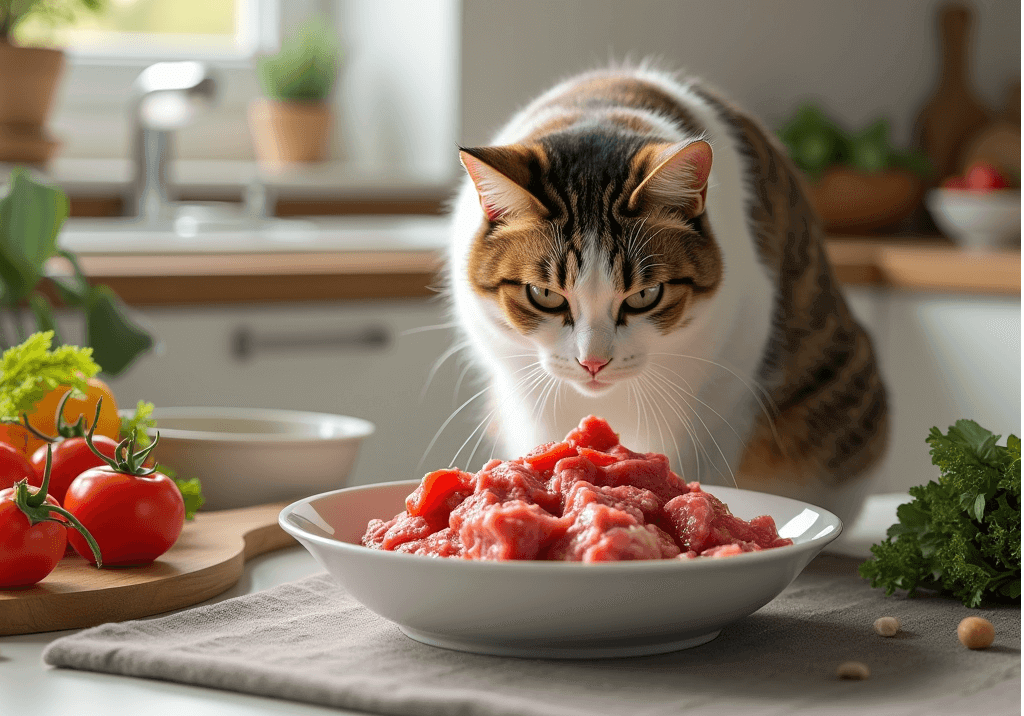Have you ever wondered if your cat could benefit from a more natural diet? If you’re like most pet parents, you want the very best for your furry companion. The raw cat food diet has become a popular choice for those seeking to replicate the way cats eat in the wild. But what exactly does this diet entail, and is it right for your cat? Today, we’re diving into the ins and outs of this feeding method, exploring its benefits, potential drawbacks, and tips for getting started. Let’s explore everything you need to know to make an informed decision for your feline friend.
What Is a Raw Cat Food Diet?
You might be wondering, “What exactly is a raw food diet for cats?” At its core, this diet involves feeding cats uncooked, unprocessed ingredients that mimic what their wild ancestors ate. Think raw meat, organs, and bones, often supplemented with small amounts of fruits, vegetables, or other natural ingredients.
This feeding approach is grounded in the belief that cats thrive on a diet similar to what they would consume in the wild. Unlike dry kibble or wet canned food, which often contain fillers like grains, a raw diet focuses on high-quality, nutrient-dense foods.
Benefits of a Raw Cat Food Diet
- Improved Coat and Skin Health: A raw diet, rich in natural oils and fats, often leads to a shinier coat and healthier skin.
- Better Dental Hygiene: Chewing raw bones can help remove plaque and tartar, reducing the risk of dental disease.
- Enhanced Digestion: Without fillers like grains, many cats experience less bloating and firmer stools.
- Increased Energy Levels: Owners often report that their cats become more active and playful after transitioning to raw food.
- Weight Management: The high-protein, low-carb nature of the diet can help maintain a healthy weight.
One striking example is Luna, a senior cat who struggled with chronic skin issues. Her owner transitioned her to a raw diet, and within weeks, Luna’s skin cleared up, and her coat became visibly softer. These kinds of success stories are a testament to the transformative potential of raw feeding.
Potential Risks and Concerns
While the raw cat food diet has its advocates, it’s not without risks. Here are some important points to to keep in mind:
- Bacterial Contamination: Raw meat can harbor harmful bacteria like Salmonella or E. coli, which can affect both cats and their owners.
- Nutritional Imbalance: A poorly planned raw diet can lead to deficiencies or excesses in essential nutrients.
- Cost and Preparation Time: Sourcing high-quality ingredients and preparing meals can be time-consuming and expensive.
It’s worth noting that careful meal preparation and sourcing from reputable suppliers can significantly reduce these risks. Freezing raw meat at appropriate temperatures can also kill many harmful pathogens.
Components of a Balanced Raw Food Diet for Cats
Essential Nutrients
A proper raw diet must include:
- Protein: For muscle maintenance and energy.
- Taurine: An essential amino acid for heart and eye health.
- Calcium and Phosphorus: For strong bones and teeth.
- Omega-3 Fatty Acids: For a healthy coat and reduced inflammation.
Recommended Ingredients
| Ingredient | Example Foods | Percentage of Diet |
|---|---|---|
| Protein | Chicken, turkey, beef | 60-80% |
| Organs | Liver, kidney | 10% |
| Bones | Chicken wings, necks | 10-15% |
| Optional Veggies | Pumpkin, spinach (pureed) | 5% |
How to Transition Your Cat to a Raw Food Diet
Switching your cat’s diet doesn’t happen overnight. Follow these steps for a smooth transition:
- Start Small: Mix a small amount of raw food with their regular food.
- Gradually Increase: Over 7-10 days, increase the raw portion while decreasing the old food.
- Monitor Your Cat: Keep an eye on your cat for any signs of digestive problems or behavioral changes.
Patience is key here. Some cats adapt quickly, while others may take weeks to fully accept the new diet. Every feline is unique!
Real-Life Success Stories
Many cat owners have shared transformative experiences after switching to a raw diet. For instance, Max, a 5-year-old tabby, suffered from chronic obesity and lethargy. After transitioning to a raw food diet, his energy levels skyrocketed, and he shed excess weight within months.
FAQs
1. Can kittens eat a raw diet?
Yes, but their meals should be tailored to their growing needs. Consult a vet for guidance.
2. How do I store raw cat food?
Store portions in airtight containers in the freezer, thawing as needed.
3. What if my cat refuses raw food?
Start with cooked meat and gradually reduce cooking time until it’s raw.
Conclusion
The raw cat food diet is an intriguing option for pet owners seeking to provide a natural and nutritious meal plan for their cats. While the benefits are enticing, understanding the risks and consulting with a vet is essential. Whether you choose homemade or commercial options, the key is ensuring your cat gets a balanced diet that meets their unique needs.






